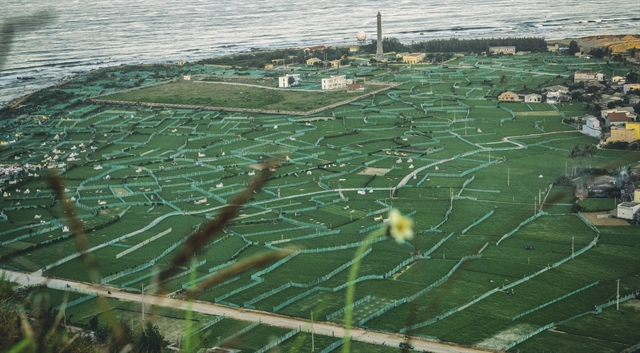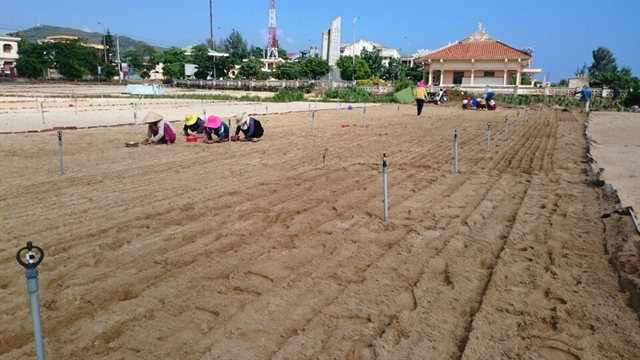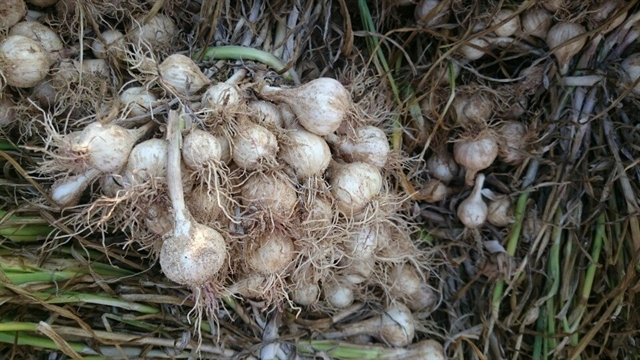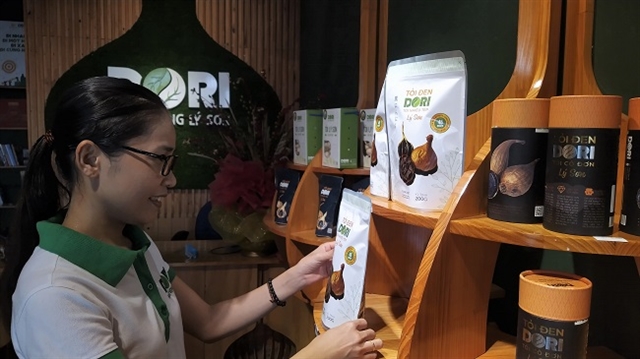 Society
Society

Although earning Geographical Indication (GI) status, organic garlic and purple onion farms occupy less than one per cent of the islands’ total 330ha of farmland.

|
| Garlic and onion farms on the Lý Sơn Islands, off the coast of Quảng Ngãi Province. The islands have been turning to organic agriculture for more sustainable development. Photo courtesy of Lê Xuân Thọ |
LÝ SƠN ISLANDS — Organically grown crops have been designated a key part of sustainable development on the Lý Sơn Islands, 30km off the coast of central Quảng Ngãi Province. Lý Sơn garlic and onions are popular throughout the country.
However, the transfer to organic farming faces hurdles from low productivity, a lack of policies supporting farmer-business partnerships and poor protection of the Lý Sơn garlic brand, which is discouraging farmers from organic farming.
Although earning Geographical Indication (GI) status, organic garlic and purple onion farms occupy less than one per cent of the islands’ total 330ha of farmland.
Farmers on the islands are still hesitant to transfer from traditional agricultural practices to organic farming, fearing low productivity, high production costs and an unstable market.

|
| Farmers begin a new garlic crop in Lý Sơn Islands. The Islands' agriculture will be going 'green' for a better environment and income in the coming years. Photo courtesy of Phạm Văn Công |
Phạm Văn Công, CEO and founder of the DORI Joint Stock Company, said only 10 farmers over 3ha are have started organic garlic farming since 2016.
Công has seen success in processing garlic into high-value dried roots, wine and essential oil products, five years after starting to trade.
“It takes at least three years to clean the chemically contaminated farmland with bio-fertiliser, manure, humus and grass, and absorbing ‘green’ nutrition,” he explained.
“Local farmers do not have enough financial reserves to last the first years of preparation for organic-based farming,” he said.
Công also said that strong farmer-business partnerships have not yet been built to make organic farms larger on the islands.

|
| Garlic growing on Lý Sơn Islands. Photo courtesy of Lê Xuân Thọ |
A report from the islands’ People’s Committee said farmers produce 2,500 tonnes of garlic and 6,500 tonnes of purple onion per year, with an annual revenue of VNĐ200 billion ($8.8 million).
Chairwoman of the Lý Sơn Islands District People’s Committee, Phạm Thị Hương, said traditional farm produce (garlic and purple onion) does not have a stable market price due to poor connections between the islands and mainland.
Hương said garlic is usually sold from VNĐ80,000 to VNĐ150,000 per kilo, but can go down to a mere VNĐ30,000.
She said the COVID-19 pandemic has kept more than 100 tonnes of garlic on the island, and the price offered was below VNĐ30,000 per kilo.
A few years ago, the islands original garlic suffered unfair competition from garlic produced in other provinces like Khánh Hòa and Bình Thuận.

|
| Garlic roots from an organic farm on the Lý Sơn Islands of Quảng Ngãi Province. Garlic is one of the most famous exports from the islands. Photo courtesy of Dori |
Green change
The islands, known as the Kingdom of Garlic in Việt Nam, have around 22,000 inhabitants, of whom 73 per cent make their living from farming garlic and spring onions, alongside fishing.
Farmers grow garlic on terrain that formed from volcanic eruptions 25 to 30 million years ago, creating the special scent that the Lý Sơn garlic is famous for.
Traditional farming methods rely on chemicals and the over-use of natural resources, though islanders have gradually begun to recognise the dangers of environmental pollution, exhausted soil and high saline intrusion.
Local farmers on the islands have been encouraged to apply safe farming techniques that use bio-fertiliser and bio-pesticide, rather than continuing to exploit coral sand and basalt soil as before.
Compost livestock waste, green leaves and seaweed are used to create ‘green’ soil bases that replace these basalt and coral sand mixtures.
The first ‘green’ crop only collected 30 per cent of the traditional capacity, but yields doubled after the second and third years. Organically produced garlic also fetches a higher market price.
Đặng Quang Trọng, who developed a 400sq.m organic farm, said each ‘green’ garlic kilo was sold for between VNĐ250,000 ($10.8) and VNĐ350,000 ($15.2).
Traditional farming requires at least 40 tonnes of chemical fertiliser and leads to 10,200cu.m of farm soil being dumped for every garlic crop produced. The 3,000sq.m dumpsite for agricultural waste on the islands was overloaded. The cost of cleaning the chemically contaminated farm soil stands at VNĐ20 billion each year, a report from the islands’ committee unveiled.
On top of this, farmers often mix sand from coastal coral reefs and basalt dug up from defunct volcanoes, which has led to serious coastal erosion and damage to the ancient volcanoes - one of the biggest tourist attractions on the island.
Võ Trí Thời, an official from the district’s Peoples’ Committee, said the islands plan to develop 100ha of VietGAP farms that promote using compost and bio-fertiliser, instead of chemical agricultural material.
Organic farming trailblazer, Phạm Văn Công, explained that farmers need financial guarantees and supportive policies from local authorities to help them through the first three years of organic farming.

|
| Garlic products, including wine, dried garlic and black garlic, on sale at a shop in Quảng Ngãi Province. Photo courtesy of Dori |
“Farmers can not find support to help them survive the low output of the initial three years of changing from chemical-based agriculture to organic farming. Organic farm produce also needs sales promotions, brand protection and respect in the market,” Công said.
He agreed that organic agriculture is not easy, but success is still ahead.
“I do hope more farmers will follow our organic demonstrations to turn the islands green.”
The islands have been designed as a ‘zero’ carbon and eco-tour site, through the promotion of renewable energy projects like solar, wind, tide and desalination, which turns seawater into freshwater. — VNS




